|
HOME: www.hiltonpond.org |
|||
THIS WEEK at HILTON POND 1-31 August 2011 Subscribe for free to our award-winning nature newsletter (Back to Preceding Week; on to Next Week) |
|
Note from Bill Hilton Jr.: I regret it has been a while since the last posting of "This Week at Hilton Pond"--my first extended hiatus in more than ten years of this on-going series of nature photo essays. In late July the 87-year-old family matriarch, Eleanor Jacqueline Byars Hilton, took a nasty fall at home, clunked her head, and developed a massive subdural hematoma that robbed her of speech and made her semi-comatose. After three craniotomies and more than a month of hospitalization and rehabilitation she has bounced back further than anyone could have expected--thanks to modern medicine, expert care, moral support, resilient DNA, and her sometimes cantankerous refusal to give up. Jackie's five children spent extended amounts of time at her bedside, which--in my own particular case--meant there was little time this month for field research, bird banding, photography, or essay-writing. Following daily 12-hour stints at various health centers in the Carolinas I did manage to return home some evenings in time to trap a few hummingbirds and, more important, can report Jackie is now talking cheerfully and has re-acquired some mobility. Alas, her short-term memory is waning but her family and friends hope she will continue to improve. Meanwhile, here at Hilton Pond I'll try to get back to investigating and sharing the world of nature--something Jackie Hilton encouraged as early as my pre-teen years. SPIDERS OF AUGUST: THE CASE FOR ARACHNOPHILIA If you THINK you are an arachnophobe--one who has a morbid fear of spiders--do NOT try to live out in the countryside. But if you DO live in the country, DON'T occupy a vintage farmhouse. If you DO dwell in an old house, be sure it DOESN'T have a light-colored exterior. If its exterior IS light-colored, make sure it ISN'T white. As you might guess, we've just described the situation here at Hilton Pond Center where our white-clad farmhouse is paradise for vast numbers of spiders of all shapes and sizes--spiders that grace our windows and doorways and eaves and attic with an equally diverse assortment of cobwebs and other silken structures (above left). Come August we're forever encountering one spider after another and stumbling into webs, but we still think everyone should share our good fortune in being surrounded by such fascinating eight-legged creatures. Yes, August seems to be spider month in the Carolina Piedmont and our farmhouse IS festooned with miles and miles of spider silk. Most mornings when we go outside we're immediately covered by cobwebs strung from doorframe to doorframe. A walk down our trails in August is painfully slow because we spend so much time going under and around webs, carefully avoiding as many as we can--not because we don't want the sticky silk plastered head to toe but because we respect the effort these industrious little arachnids expend in spinning their snares. We own a couple of good spider field guides but still can't identify all the species that occur at Hilton Pond; nonetheless, we wanted to share images of several we found in recent weeks on farmhouse white vinyl or in our nearby woods, intending all the while to infect you with an incurable case of arachnophilia--NOT arachnophobia.
All text & photos © Hilton Pond Center Perhaps the most abundant spider we found on siding of the old Hilton Pond farmhouse was a little brown one (above) about 3/8" long from leg tip to leg tip. This unidentified arachnid appears to be a sheet-weaver (Linyphiidae)--a type of spider that weaves a relatively flat, dense, horizontal web and lurks at one end until a prey item falls in. When the hapless insect struggles, the spider senses movement and rushes out of its lair to pounce on its next meal. After paralyzing the prey with a quick injection of poison, the spider wraps up the insect in silk to form a barely living "mummy" that can be revisited and snacked upon at some later time. Yummy! (NOTE: If you know a common name or species for any of the "unidentified" spiders on this page, please send an e-mail to INFO.)
All text & photos © Hilton Pond Center In the same sheet web as the unidentified brown spider was what looked like a dead arachnid. On closer examination we concluded it wasn't a carcass but an old exoskeleton. All spiders are covered by thin and relatively inflexible armor that provides excellent protection from dehydration, parasites, and small predators. It gets in the way, however, as a spider matures and goes through several growth stages. The only way the spider can get any larger is to burst out of its chitinous skin, leaving the old sheath behind. A remarkable aspect of the exoskeleton is that it covers every part of the spider's body--even the eyes that show as pale gray ovals in the photo just above.
All text & photos © Hilton Pond Center Discarded spider exoskeletons weren't the only things we discovered in spider webs around the Hilton Pond farmhouse. In fact, as August progressed we found more and more webs with brownish objects that were round or teardrop-shaped (above).
All text & photos © Hilton Pond Center Female spiders continue to guard their egg sacs even after eggs hatch--not a bad strategy when we note that as many as a hundred tiny spiderlings (above) will emerge almost simultaneously. (Some spider mothers take spiderling protection even further by allowing youngsters to hitchhike on their abdomens.)
All text & photos © Hilton Pond Center Baby spiders typically are quite small--the ones in the macrophotograph above are less than a millimeter across--but they are fully formed. However, like many newly hatched or just-born organisms, their bodies are disproportionately large in comparison to their appendages. Several spiderlings at upper right are already venturing out on their mother's silken web and may escape one of the greatest dangers faced by a baby spider: Being eaten by one's siblings. Indeed, cannibalism is rampant among immature spiders, who find the cohorts next to them to be handy sources of nutrition.
All text & photos © Hilton Pond Center And speaking of spiders eating spiders, we originally thought the half-inch-long adult spider above was holding on to a cast-off exoskeleton, but when we enlarged the image we discovered the arachnid was actually dining on another arachnid! Indeed, cannibalism IS common among spiders, and it's not unheard of for a female of any given species to consume a smaller male after mating.
All text & photos © Hilton Pond Center Just above is another image of a spider seemingly floating on air when it's actually hanging from very fine silken threads invisible in the photo. This unidentified individual had a body less than a quarter-inch-long but bore amazingly long front legs. The photograph also shows something you may have noted in previous images on this page: Spiders typically have few to many hair-like projections on their legs. Some arachnologists speculate these structures--not true hairs but extensions of the exoskeleton--help spiders sense when prey items enter their webs. This might be a valid assumption for web-spinning spiders, but hunting spiders that stalk prey rather than snaring them also have "hairy legs." Some New World tarantulas even have hollow abdominal hairs that scratch noses and eyes of potential predators and release irritating chemicals in a process known as "urtication."
All text & photos © Hilton Pond Center Among arachnids that take exoskeleton projections to the extreme are the micrathenas--a widely distributed Western Hemisphere spider genus whose members have prominent horns on their abdomens. Pictured above is Micrathena gracilis, the Spined Micrathena, with a dragonfly in her grip. Micrathenas are orbweavers (Araneidae) that are particularly abundant in August around the shores of Hilton Pond, where we surmise their horny projections deter potential predators from biting the spider. We can attest from experience the horns can hurt, especially when a micrathena drops unexpectedly on one's neck and one slaps at the spider. Under such pressure the micrathena's horns dig into one's skin and can be rather painful, making one think one has been bitten by some dangerous woodland creature. We're pleased to say the pain is short-lived, and any armored micrathena involved in this scenario simply drops to the ground before walking off to build another web. Incidentally, because of the dragonfly included in the photo above the Spined Micrathena may appear to be enormous, but in actuality the female's abdomen is less than a half-inch long and the dragonfly is one of our smallest species--Eastern Amberwing, Perithemis tenera.
All text & photos © Hilton Pond Center Another tiny orbweaver we found this week in the woods at Hilton Pond was the green-legged one in the photo above. Thanks to Web site visitor Patrick Belardowe we now know it's an Orchard Spider, Leucauge venusta, a member of the Long-jawed Orbweaver Family (Tetragnathidae)--an East Coast species that occurs from southern Canada to Panama. This spider was especially hard to photograph for two reasons: 1) It was quite small--only about 1/2" across, counting its legs, and 2) Even the slightest breeze moved the web and spider in and out of focus. We suspect the green color in the spider's legs comes from hemolymph--an arachnid's circulatory fluid that is analogous to the blood and plasma of higher animals. However, red blood cells in mammals, for example, contain iron-based hemoglobin that turns red in the presence of oxygen, while the spider's hemolymph contains a copper compound that turns green. We're guessing the exoskeleton is thin enough in the legs of the spider above that oxygen can pass through and keep the hemolymph greenish.
All text & photos © Hilton Pond Center We looked long and hard for one other orbweaver and finally discovered it among Swamp Milkweed growing on the eastern bank of Hilton Pond. Our quarry was a nearly three-inch-long Black-and-Yellow Argiope "hiding" behind her stabilimentum--a dense area of silk that conjures up visions of written script and gives the species its common name of "writing spider." One myth has it that when you see your name spelled out by a writing spider you might as well call the undertaker, while another says if you decipher the word "war" in the stabilimentum it means a major conflict is imminent. We aren't sure about the credibility of such stories but we do know this spider species means the end is nigh for a wide variety of insects that get caught in the massive sticky web of Argiope aurantia.
All text & photos © Hilton Pond Center The web of a Black-and-Yellow Argiope really can be surprisingly big--we've seen them nearly three feet in diameter--but other spiders make equally large webs. Such was the case with one we located in shrubby growth not far from Hilton Pond, where a funnel-weaver spider (Agelenidae) had covered the substrate with a web four feet long by three feet wide (above). Near its center was the funnel (AKA "tunnel") that gives this species its common name. We caught a glimpse of the spider but spooked it when we closed in for a photo, so we quietly placed the camera on a tripod, lined up the lens, and backed away for a while to see if the arachnid would emerge.
All text & photos © Hilton Pond Center An hour or so later the elusive and unidentified funnel-weaver (Agelenopsis sp.?) did peer out with eight beady little eyes before sauntering from its hiding place. If we were some sort of wandering insect this appearance would have had us scrambling to get out of the way of that vicious pair of fangs just below the spider's eyes. One bite from such formidable weapons and a moth or beetle would quickly succumb to becoming another morsel in the funnel-weaver's larder.
All text & photos © Hilton Pond Center You'll note our lead sentence in this photo essay about spiders says "If you THINK you are an arachnophobe," with the emphasis on the word "THINK." We chose that phrasing because no one is BORN with a fear of spiders and therefore must ACQUIRE that fear. It follows that if one can learn to be afraid of arachnids, one can likewise learn NOT to fear them--although it may take a little effort and some open-mindedness. One way to start overcoming your fear is to go back and re-read this essay, stopping to carefully study each spider photograph. Look closely at the spider's amazing external anatomy and its symmetry, at its eight legs and multiple eyes and complex mouthparts. Think about the spider's reproductive strategies and how most females guard egg cases containing future progeny. Marvel at the spider's ability to fling thin strands of silk from its spinnerets while weaving an incredible web whose form and function are worthy of awe. And, lastly, ponder the role spiders play in the natural world, snaring and consuming incalculable numbers of insects that--in many cases--might otherwise bite you or eat crops we humans need on a daily basis. Yes, there's no rational reason NOT to replace your arachnophobia with arachnophilia after you go out to observe these eight-legged wonders that abound during August at Hilton Pond Center--and just about everywhere else. All text & photos © Hilton Pond Center
POSTSCRIPT: Younger son Garry Hilton, a senior dance education major at the University of South Carolina, has worked part time for several years as Colorguard and Winterguard instructor at White Knoll High School in Lexington SC. His colorguard girls appear with the school's 2010 state champion 4A marching band, performing dance routines that include flag, rifle, and sabre work. Interestingly, the theme for this year's band show is "Arachnophobia" (closer flag, above), in which the band and guard play, march, and perform to original music. In Garry's words, "This year's show explores a very common fear--arachnophobia, the aversion to spiders. We examine all aspects of arachnids and the effect they have on those who experience anxiety over these small creatures. The band's music exudes the 'creepy' feelings many folks have upon seeing or contacting spiders, while the colorguard personifies the spider by portraying characteristics of arachnids themselves." We look forward to watching the White Knoll marching band and guard perform "Arachnophobia" in competition this fall but have considered making up some "Arachnophilia" T-shirts to tell the OTHER side of the spider story. |
 The Piedmont Naturalist, Volume 1 (1986)--long out-of-print--has been re-published by author Bill Hilton Jr. as an e-Book downloadable to read on your iPad, iPhone, Nook, Kindle, or desktop computer. Click on the image at left for information about ordering. All proceeds benefit education, research, and conservation work of Hilton Pond Center for Piedmont Natural History. The Piedmont Naturalist, Volume 1 (1986)--long out-of-print--has been re-published by author Bill Hilton Jr. as an e-Book downloadable to read on your iPad, iPhone, Nook, Kindle, or desktop computer. Click on the image at left for information about ordering. All proceeds benefit education, research, and conservation work of Hilton Pond Center for Piedmont Natural History. |
|
|
"This Week at Hilton Pond" is written and photographed by Bill Hilton Jr., executive director of Hilton Pond Center for Piedmont Natural History
|
|
|
If you Twitter, please refer
"This Week at Hilton Pond" to followers by clicking on this button: Tweet Follow us on Twitter: @hiltonpond |
Comments or questions about this week's installment? Send an E-mail to INFO. (Be sure to scroll down for a tally of birds banded/recaptured during the period, plus other nature notes.) |

Click on image at right for live Web cam of Hilton Pond,
plus daily weather summary
Transmission of weather data from Hilton Pond Center via WeatherSnoop for Mac.
|
--SEARCH OUR SITE-- For a free on-line subscription to "This Week at Hilton Pond," send us an |
|
Thanks to the following fine folks for recent gifts in support of Hilton Pond Center for Piedmont Natural History and/or Operation RubyThroat: The Hummingbird Project. Your tax-deductible contributions allow us to continue writing, photographing, and sharing "This Week at Hilton Pond." Please see Support if you'd like to make a gift of your own.
|
|
Make credit card donations
on-line via Network for Good: |
|
|
Use your PayPal account
to make direct donations: |
|
|
If you like shopping on-line please become a member of iGive, through which 800+ on-line stores from Amazon to Lands' End and even iTunes donate a percentage of your purchase price to support Hilton Pond Center .
 Every new member who registers with iGive and makes a purchase earns an ADDITIONAL $5 for the Center. You can even do Web searches through iGive and earn a penny per search--sometimes TWO--for the cause! Please enroll by going to the iGive Web site. It's a painless, important way for YOU to support our on-going work in conservation, education, and research. Add the iGive Toolbar to your browser and register Operation RubyThroat as your preferred charity to make it even easier to help Hilton Pond Center when you shop. Every new member who registers with iGive and makes a purchase earns an ADDITIONAL $5 for the Center. You can even do Web searches through iGive and earn a penny per search--sometimes TWO--for the cause! Please enroll by going to the iGive Web site. It's a painless, important way for YOU to support our on-going work in conservation, education, and research. Add the iGive Toolbar to your browser and register Operation RubyThroat as your preferred charity to make it even easier to help Hilton Pond Center when you shop. |
|
|
SPECIES BANDED THIS WEEK: * = New species for 2011 WEEKLY BANDING TOTAL 4 species 131 individuals 2011 BANDING TOTAL 28 species 1,817 individuals 126 Ruby-throated Hummingbirds 30-YEAR BANDING GRAND TOTAL (since 28 June 1982, during which time 170 species have been observed on or over the property) 125 species (30-yr avg = 67.0) 56,694 individuals (30-yr avg = 1,890) 4,414 Ruby-throated Hummingbirds (28-yr avg = 158) NOTABLE RECAPTURES THIS WEEK (with original banding date, sex, and current age): Ruby-throated Hummingbird (4) 07/05/09--after 3rd year female 05/28/10--after 2nd year female 09/17/10--2nd year male 09/22/10--2nd year male |
OTHER NATURE NOTES: --This year we had banded only five Ruby-throated Hummingbirds at the Center through the end of July, but the anticipated influx began right on schedule around the first of August. By month's end our number of new RTHU had grown exponentially to 126--well ahead of our 28-year average of 106 banded by 31 Aug. In 2011 we've also recaptured 25 RTHU banded at Hilton Pond in previous seasons. --Several House Finches trapped at the Center during the period had one or both eyes infected with conjunctivitis, a contagious disease that some HOFI apparently acquire while still in the nest. We suspect this malady--which affects membranes around the eye and can cause blindness--is a major cause of fatalities among recently fledged HOFI. All text & photos © Hilton Pond Center |


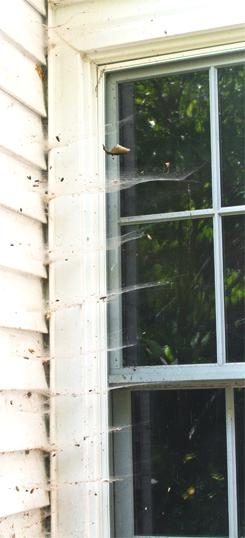 And if your dwelling DOES happen to be an old white farmhouse in the country, by all means be sure the light exterior is NOT the result of easily dirtied white vinyl siding with its inherent cracks and crannies. Those crevices where siding meets molding provide countless places in which spiders hide by day and from which they spin innumerable webs by night--and NOTHING makes those spider webs more obvious than a background of good ol' white vinyl siding.
And if your dwelling DOES happen to be an old white farmhouse in the country, by all means be sure the light exterior is NOT the result of easily dirtied white vinyl siding with its inherent cracks and crannies. Those crevices where siding meets molding provide countless places in which spiders hide by day and from which they spin innumerable webs by night--and NOTHING makes those spider webs more obvious than a background of good ol' white vinyl siding. 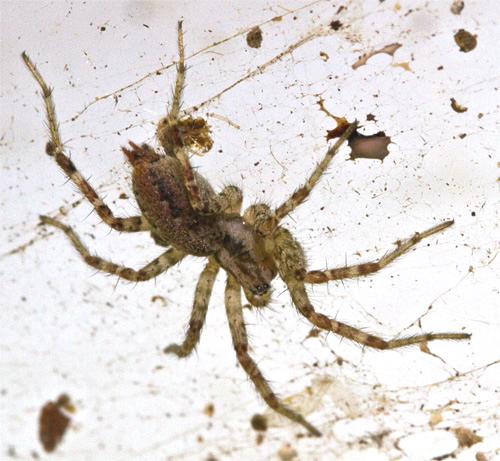
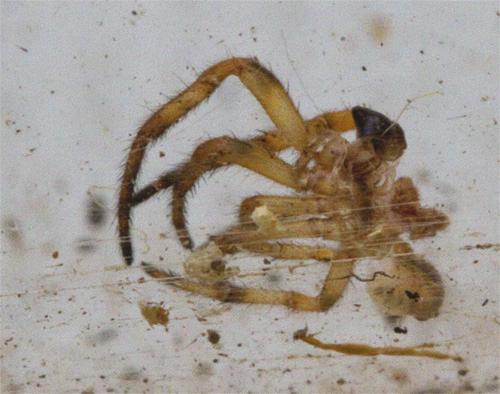

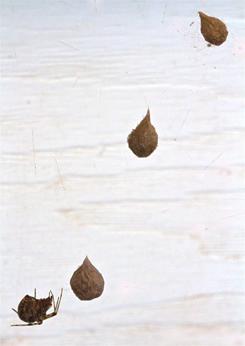 These, of course, were spider egg cases--tough little bags of dark silk typically being guarded by the adult female that wove each structure and filled it with her future offspring. One female appeared to be particularly fecund, having produced three different egg cases that seem to be suspended above her (right). (We mention at this point something that might already be obvious: Spiders and egg cases in our photos are not mysteriously defying gravity. It's just that spider webs are hard to photograph, and silken strands typically do not show up against a background of white vinyl siding.) One interesting thing about the three egg cases in the photo above right is the female apparently got better and better at making them, with the topmost case being smaller and poorly formed while the newest is bigger and close to perfect.
These, of course, were spider egg cases--tough little bags of dark silk typically being guarded by the adult female that wove each structure and filled it with her future offspring. One female appeared to be particularly fecund, having produced three different egg cases that seem to be suspended above her (right). (We mention at this point something that might already be obvious: Spiders and egg cases in our photos are not mysteriously defying gravity. It's just that spider webs are hard to photograph, and silken strands typically do not show up against a background of white vinyl siding.) One interesting thing about the three egg cases in the photo above right is the female apparently got better and better at making them, with the topmost case being smaller and poorly formed while the newest is bigger and close to perfect.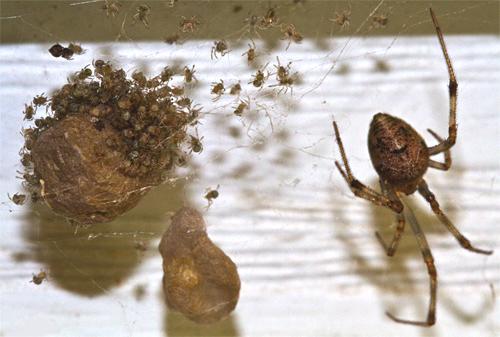
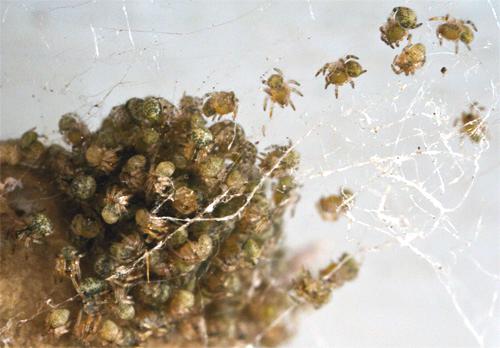

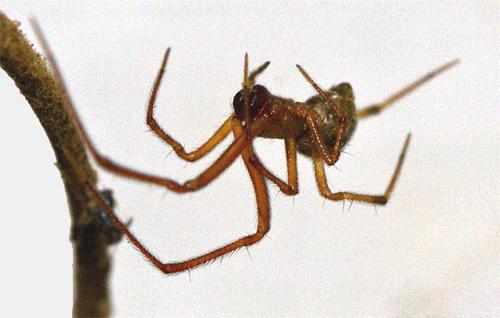
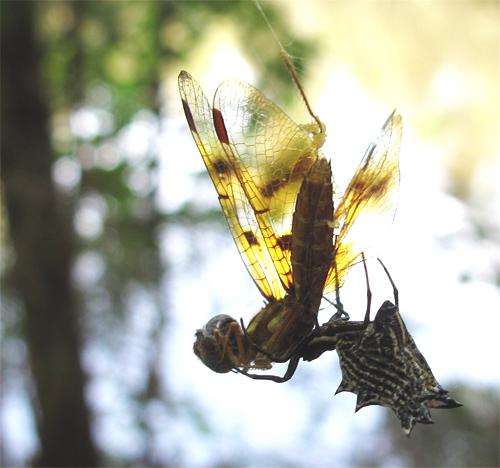
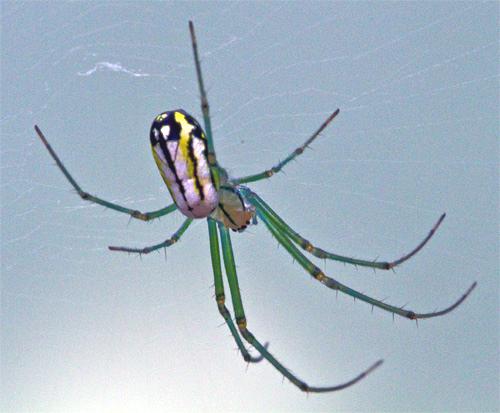
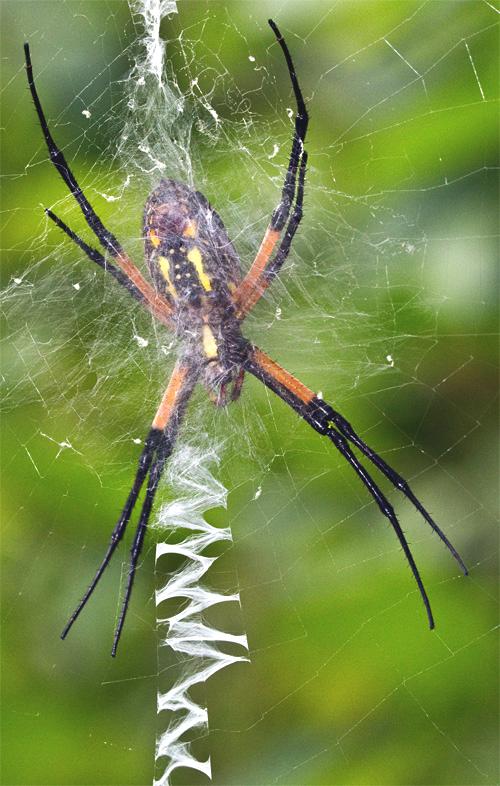
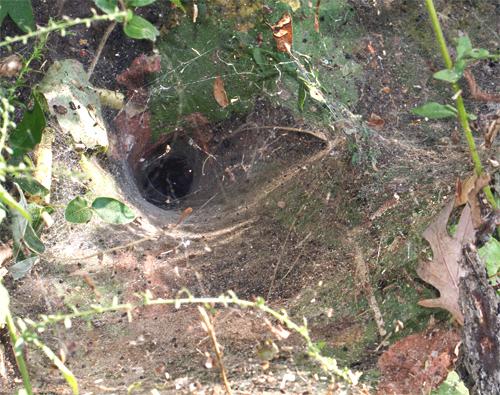

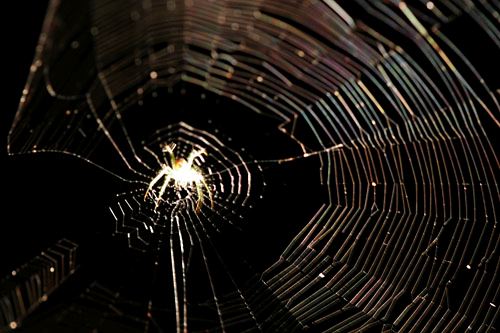


 Please report your
Please report your